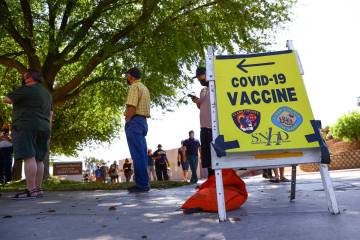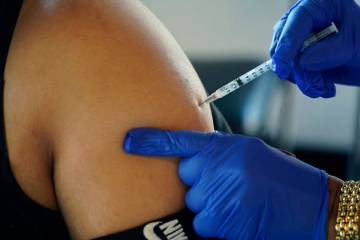COVID-19 deaths in Nevada, Clark County fall to lowest point in pandemic
COVID-19 deaths in Nevada fell to their lowest point of the pandemic this week, while numbers of hospitalizations and cases continued their free fall.
The 14-day average for daily new deaths fell to zero in both the state and in Clark County for the first time since the start of the pandemic, according to new data posted Wednesday on the state’s COVID-19 online dashboard.
At the highest point, in January 2021, the average for daily new deaths in the state rose to 43, according to dashboard data from the Nevada Department of Health and Human Services.
Confirmed and suspected COVID-19 hospitalizations in Clark County have dipped below 100, the number two weeks ago, to 87. Statewide, hospitalizations declined to 115 from 143 in the two weeks since the dashboard, which was undergoing maintenance, was last updated.
The 14-day average for confirmed daily new cases in the county fell to 96 from 137 in the span of two weeks. Statewide, daily new cases declined to 144 from 197.
The drops coincide with President Joe Biden’s remark this week on CBS’ “60 Minutes” that the pandemic is over. Although there is disagreement among health officials over whether indeed the pandemic phase is over, they agree on one thing: COVID-19 is not yet done with us.
Entering a new phase
The decline in fatalities and reduction in the stress on hospitals, along with the population’s growing immunity to the virus and expanded treatment options, all suggest that COVID-19 is entering an endemic phase, said Dr. William Schaffner, a professor of infectious disease at Vanderbilt University.
In an endemic phase, COVID-19 remains a constant, but more routine, part of life.
“In many ways, this presents new challenges,” Schaffner said. “How are we going to keep COVID down? To continue to maintain our level of protection in the population such that we can continue to keep people out of the hospital?
“That will require sustained effort, something we’re not good at in the United States,” he said. Vaccination will continue to be “absolutely fundamental,” and those who are frail should consider continuing to take precautions such as masking and social distancing.
Epidemiologist Brian Labus said that while it appears that COVID-19 is becoming endemic, “it’s one of those things you can’t say until after the fact,” like that summer is over.
“We could have two beautiful weeks, and the first week of October could be 110 (degrees),” said Labus, an assistant professor at UNLV’s School of Public Health.
A spoiler to the end of the pandemic would be the emergence of a new and more infectious variant resulting in yet another surge in cases, hospitalizations and deaths, Labus and other authorities said.
The potential for such a variant is one reason that Julie Swann, a professor at North Carolina State University, does not consider the pandemic to be over.
“In the upcoming months, we should continue our surveillance of virus variants, looking especially for ones that are highly transmissible or escape previous immunity or increase severity of outcomes,” said Swann, who studies COVID-19 data and trends.
Although deaths from the virus are declining nationwide, they continue to be high, she noted. There were nearly 2,500 COVID-19 deaths across the country in the last seven days, according to data from the Centers for Disease Control and Prevention.
Swann said, “We may have made it through a recent storm, but the hurricane season of SARS-CoV-2 is not over yet.”
Contact Mary Hynes at mhynes@reviewjournal.com or 702-383-0336. Follow @MaryHynes1 on Twitter.






































